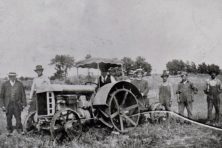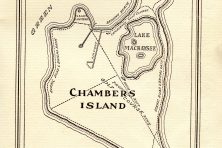Golf by Design – the Origins of Door County’s Courses
- Share
- Tweet
- Pin
- Share

Who designed Door County’s golf courses? Do-it-yourselfers, famous architects – and nature
This is part one of a two-part look at the people behind the design of Door County’s 10 golf courses. Part two will be found in the Summer edition of Door County Living, available July 1.
Door County’s nine public golf facilities and one private resort course each have character, style and appeal all to themselves, and there’s one big reason for that: They have no designers in common. “Variety” is definitely the word for Door County’s golf challenges and the history of its courses.
The Alpine (18 holes, but previously 36) had four separate architects by the time the Black Nine opened in 2001. Over a century, Peninsula State Park Golf Course has also had four different creators, counting Lohman Golf Design, which planned the award-winning, donor-funded, six-hole short course across Highway 42 from the driving range seven years ago.

Maxwelton Braes Golf Course 
Peninsula State Park Golf Course
Door County courses benefit from the peninsula’s great variations in topography and scenery, and their designers worked with the land while creating entertainment and challenges for golfers. A few of the designers are renowned in the golf world; some have been forgotten, despite their lasting achievements; and two little-known designers were involved in creating two of the most dizzying and famous holes in the county.
Multiple golf websites and Peninsula State Park Golf Course pro Jason Daubner say the 1931 efforts of Midwest club pro and clubmaker William “Bim” Lovekin led to the construction of Peninsula holes including the difficult, par-3 17th, which requires a shot from the top of the state park’s sledding hill to the bottom of it. That hole, combined with a 69-yard tee shot to the eighth green 50 feet below, make a round at Peninsula downright unforgettable.
And Fritz Schaller, designer of The Woods in Green Bay and former course superintendent of Shorewood at UW-Green Bay, designed the Alpine’s former Blue Nine, which includes the 270-yard, par-4 ninth hole, said Bill Bertschinger, whose family previously owned the Alpine Resort. Course managers plan to make it the finishing hole again this spring.
Golfers tee it up on top of the Niagara Escarpment and hope they hit it straight. From the top of the cliff – other than the waters of Green Bay as the backdrop – players see a narrow, tree-lined fairway and green 120 feet below.
And then there were the unknown – or at least forgotten – designers. Cherry Hills was originally named Pepperdine when it opened in 1977. Larry Rand, owner of Royal Scot near Green Bay and Cherry Hills manager in the early 1980s, said course builder David Truttmann designed it for developer George Marcantonio on former Martin Orchards land.
Truttmann’s architecture provides great variety and forces golfers to hit it extremely straight on narrow fairways through forest on three holes on the back nine. Cherry Hills’ builders capitalized on elevation changes, requiring downhill tee shots to the par-3 second and eighth greens. And spectacularly, they created a fairway on the par-4 15th hole that leads to a cliff about 240 yards from the tee. Originally, the cliff featured a manmade waterfall that recycled through a pump and reservoir.
Parkside Sanctuary

As a neighbor to Potawatomi State Park, Idlewild Golf Course – called Lost Creek in the 1970s by early developers, including John Mendonca – puts golfers into peaceful, natural settings while also providing many maddening moments for those who don’t hit their ball straight. The wetlands and lowland woods attract enough birds and wildlife that Idlewild could double as an Audubon sanctuary.
Head professional Brandon Hansen wasn’t familiar with the designer, but said the course provides a good mix of easier and difficult holes, and it forces players to use every club in their bag. There’s no shrine to the architect, but it’s the work of Homer Fieldhouse – a Frank Lloyd Wright-influenced nurseryman’s son and a college-trained landscape architect who’s credited with work on 60 courses and who landscaped Wisconsin’s pavilion for the 1964 World’s Fair.
Picturesque when viewed from the second-story Pub and Grill, the
par-5 ninth provides an opportunity for players to try for the island green in two, but go-getters risk plunking a shot into the water.
Golfers won’t need cameras to remember some difficult holes at Idlewild, including the par-4 fifth hole, which requires a long, perfectly placed drive because of water to the right of the fairway, and then a long carry on the approach because of a creek in front of the green.
Door County residents moved countless tons of rock to create Maxwelton Braes between 1929 and 1931. The golf course and resort construction resembled the great public-works projects carried out by the Works Progress Administration, but in this case, Baileys Harbor native and Sunbeam Corporation president Michael McArdle footed the bill, used local materials and put local people – and up to 12 teams of horses – to work, said historian Kriss Schorer, McArdle’s niece. McArdle died before the course opened.
He and Schorer’s father, Jim, started to sketch out ideas for the course during the early 1920s, and the short, par-4 first hole looks nearly identical to that sketch today, except sand is gone from two fairway bunkers.
An avid golfer who played at the Westmoreland Country Club north of Chicago, McArdle hired north-suburban golf professional Joe Roseman to complete the design.

Though Roseman designed or redesigned 150 courses, he’s most famous as a “father of modern mowing equipment,” starting with his invention of a three-gang mower that was pulled by horses. His designs span from Racine Country Club and Petrifying Springs in Kenosha in Wisconsin to Fort Lauderdale Country Club’s south course (1926).
Peninsula State Park Superintendent A.E. Doolittle was reportedly a “bit dictatorial,” but his layout of trails and roadways throughout the park survives to this day, said Rudy Carl, a 95-year-old golfer who played Peninsula State Park Golf Course regularly for seven decades.
Likewise, Doolittle oversaw the layout of the golf course’s initial six holes, and in 1923, an expansion to nine holes, according to the course’s website. Today, the first hole along the park’s north entrance road remains much as it has been from the very beginning, except, for part of the 20th century, the course had sand-and-oil greens. Initially, the second hole was across present-day Highway 42.
Many of the oldest holes from the days of Doolittle and Lovekin remain in place today, such as the course’s most famous hole: the 69-yard, par-3 eighth hole, which requires a tee shot off a cliff, and the bluff-edge 11th hole.

Peninsula did not have a well-known architect until the early 1960s, when Lawrence Packard oversaw the redesign. He worked on more than 100 course projects, with most in Illinois, Wisconsin and Florida.
Some of the original 18 holes truly needed redesigning by the 1950s, such as the second, which once required players to hit a blind uphill drive from a tee box built on a rectangular flagstone structure partway down the bluff, Carl said. The redesign eliminated a par-3 hole that had a green in approximately the same spot as the present-day ninth. That mid-century green’s surface matched steep terrain near the clubhouse almost exactly, and Carl recalled the slope being terrible.
As recently as 1958, the 12th hole struck fear of injury into golfers. The hole paralleled the 17th, which serves as the park’s sledding hill, and the tee box sat too close to the 17th green for golfers. They probably should have worn hard hats.
Carl loves the “new” (circa 1960) risks of the Packard-designed par-4 12th, with its roller-coaster fairway and a severe drop-off along the entire left side. Players can’t see the landing area from the tee, so groups in front ring a bell to give players behind them the all-clear to swing away.
“The 12th hole is a terror,” Carl said.
Longtime Alpine clubhouse employee Pete Hickey noted that the Red, White and Blue Nines at Alpine provided distinctly different experiences. He called the old 1920s-era Red Nine “charming.” With holes #1, #6, #7 and #8 perched alongside the forested Niagara Escarpment, that first nine can be friendly – or punishing if you slice.
Alpine Resort founders Paul and John Bertschinger did not build the first nine. Arn Glidden opened the course during the early 1920s. In 1926, Glidden was “on the rocks” and asked the Bertschinger brothers to buy it, said Bill Bertschinger, Paul’s son.
Bill, who – along with family members – owned the resort for 99 years until a sale in May 2020, said documents don’t clearly show who designed the White Nine, and until his dad and brother were dead, he never had a reason to ask.

Whoever designed it in 1948 created a straight, but demanding track. Golfers got a wakeup call from the 196-yard, par-3 fourth hole below the bluff, followed by back-to-back par-4s stretching out well over 400 yards and a 235-yard par-3 that often calls for a driver from the tee.
Bertschinger said he got into a “row” with planner Fritz Schaller during the Blue Nine’s construction. Schaller asked Bertschinger to stop telling him what to do so he could think. Bertschinger said he left the designer alone, and Schaller worked harder than ever to complete the job in 1976.
In 2001, Bertschinger himself designed a fourth nine (now closed), including a stunning, 180-yard hole wrapped alongside the edge of the harbor.






